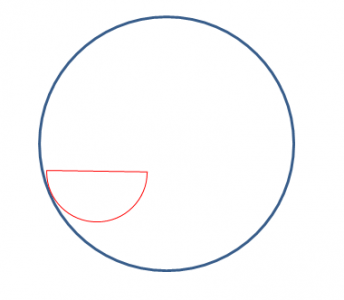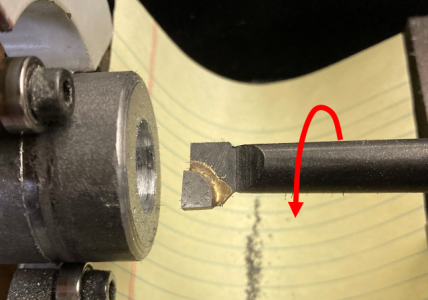Late to the party but wanted to chime in with my two cents.
Your lathe is more than capable of boring your work piece, Richard, as is your boring bar. I do agree with Stu, Mark and Pontiac that the bar needs to be sharpened a bit before it will cut but you can do that with a simple diamond stone. Trust me; I've bored MANY holes in all sorts of materials on a little Sherline lathe with those Chinese bars and while they don't finish nearly as well as better HSS and inserted carbide bars, they will bore a decent hole when used properly.
First thing to do is sharpen the carbide tip. Get yourself a fine diamond stone. The cheap credit card ones work well for this. If you don't have one then go buy one. You want to sharpen the side and end edges (just follow the factory angle) so hone the side and end faces and flatten the top. The side/end/top faces should meet at very sharp edges. Now put a very tiny nose radius on it to reduce chances of breakage with heavy cuts.
Set the bar in the holder and look at the bar from the front end so you are seeing the top of the carbide tip. You want the nose radius of the tip to point ever so slightly upward, just enough so the top is not quite horizontal. This gives you a tiny bit of positive rake and that is all you need with this tool. Now put the tool holder on your tool post and use a tool height gauge to put the tip at center height OR use your tailstock center to get the tip of the bar on center, THEN raise the tool up 0.005 - 0/010" above center height and lock the tool in the tool post.
Next, align the bar so that the centerline of the bar parallels the ways, then cant the bar to the left about 5-10 degrees or so. Your bar is now a little above center height to accommodate tangential cutting forces. It is also turned up with a bit of positive rake to further reduce tangential forces. It is canted in the bore that 5-10 degrees to reduce radial forces. And it is sharp.
Now the bar will cut.
Carbide needs speed to cut BUT this carbide is brazed onto Chinese unknownium steel so I would calculate your rpm by using a cutting speed of about 140 sfm or so for steel and I bet the bar will cut well. Experiment to see what depth of roughing and finish cuts your bar can take.; My bars can take finish cuts in the 0.005" range but your results will likely vary.
Feed fast enough to produce chips that look like coil springs, not dust. Dust is from a dull tool run at too light a cut at a slow feed.
I used those cheap bars for several years before deciding to learn how to really bore so I know they work. Granted, cobalt works WAAY better and inserted carbide on a carbide bar is even harder to beat but don't let anyone tell you that you cannot learn to bore with those Chinese bars. Good luck and I hope this helps.




